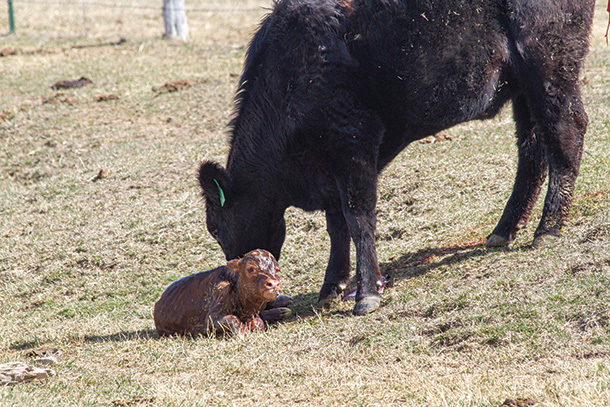Hopefully orphaned or problem calves are not a common or regular occurrence on your operation. Nonetheless, the unfortunate reality is that all operations will experience situations from time to time that require intervention to ensure that a newborn calf gets off to the right start. Maybe a first-calf heifer doesn’t claim her calf. Maybe the calf won’t nurse. Maybe it needs to be moved inside and separated from its dam so it doesn’t freeze. Whatever the reason, it is important to be prepared for such situations before they arise.
Colostrum is key
The importance and value of colostrum to a newborn calf cannot be overstated. Most calves that don’t receive adequate colostrum in a timely manner will not survive. It’s as simple as that. There is a common misconception that the calf will be fine if it receives some colostrum within the first 48 hours of life. That is often far from true. Calves are born with small openings in the gut that allow immunoglobulins from colostrum to be absorbed and to populate the immune system with antibodies. These openings begin to close immediately upon birth. Most of the closure occurs within the first 12 to 16 hours of life and is complete or nearly complete by 24 hours. Once closed, the immunoglobulins can no longer be absorbed intact, and therefore will no longer populate the immune system.
Ideally, a calf will receive colostrum from nursing its dam within the first few hours of life, however, some situations will require the calf to receive colostrum some other way. Milking the dam and either feeding her colostrum to the calf via bottle or (if necessary) esophageal tube should be the first choice. Nonetheless, some situations just won’t allow that, or may require too much effort or risk. If that is the case, the dam’s natural colostrum must be replaced with colostrum from another source.
Replacing colostrum
Two primary options exist to replace a dam’s colostrum. One option is to replace it with colostrum obtained from a local dairy. While this is often the cheapest option, there are health risks associated with obtaining colostrum from another herd. Some diseases can be transferred through colostrum. Because of the risk, it is important to involve your veterinarian in determining whether colostrum from a different herd is the best option for your operation. The following guidelines may be useful if obtaining colostrum from a dairy is deemed the best option for your operation:
- Obtain multiple doses of fresh or frozen high-quality colostrum at least one to two months prior to the beginning of each calving season. Freeze or keep frozen until needed.
- Thaw frozen colostrum immediately prior to feeding by submerging it in warm water. Do not use a microwave, and do not re-freeze thawed colostrum. Warm to approximately 105°F. Avoid using boiling or excessively hot water. Cooking denatures immunoglobulins and renders them immunologically useless.
- Provide approximately 2 quarts of colostrum to the calf as soon as possible following birth and repeat at 8 to 12 hours of age. Discard any unused thawed colostrum.
Alternatively, a more bio-secure option is to utilize a commercially available colostrum replacer. Colostrum replacers typically consist of a dehydrated colostrum- or serum-based powder that need to be reconstituted with warm water immediately prior to feeding. These products are expected to provide a high enough level of IgG immunoglobulins to sufficiently replace the dam’s colostrum and populate the calf’s immune system with antibodies. These products also serve as a source of nutrients to the newborn calf.
Colostrum replacers and colostrum supplements are typically not equivalent to one another and should not be used interchangeably. The exception to this is that some products are designed to serve as a supplement or replacer when different amounts are provided to the calf. This is not true for all products, so follow the label. Supplements are typically less expensive than replacers but provide less immunoglobulins. As a result, supplements are not expected to sufficiently replace the level of antibodies provided by the dam’s colostrum. However, supplements can be used to help boost antibody levels of calves that may have consumed low-quality and/or a small amount of colostrum. Examples of calves that may benefit from a supplement include calves born to underconditioned dams or those that get separated from their dams during or soon after nursing for the first time.
Colostrum replacers also differ from milk replacers and therefore should not be used as substitutes for one another. Milk replacers primarily provide the calf with nutrients rather than immunoglobulins and thus are not a substitute for colostrum. While often more expensive than obtaining colostrum from a dairy, colostrum replacers are typically more convenient, can be prepared more quickly and minimize the risk of disease transmission across herds. The following guidelines will help to ensure the successful use of colostrum replacers if they are part of your plan:
- Select and purchase a product that will fulfill its intended purpose.
- Obtain enough of the product to meet the needs of your expected “worst-case scenario” prior to the calving season.
- Some products require more than a single “dose” to effectively replace colostrum.
- Read the label and follow its guidelines to properly store, prepare and administer the product.
Not being prepared to provide colostrum to calves in need can have long-lasting implications to their health and growth performance and ultimately can result in the loss of a calf that could have otherwise been saved. Have a plan, and if you find yourself in the situation where you are overprepared and don’t need to put it to use, consider that a win.












